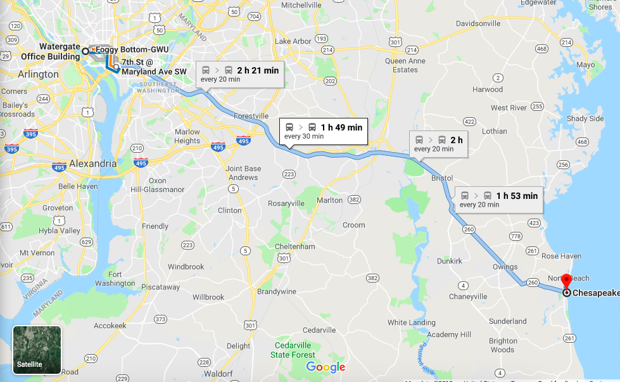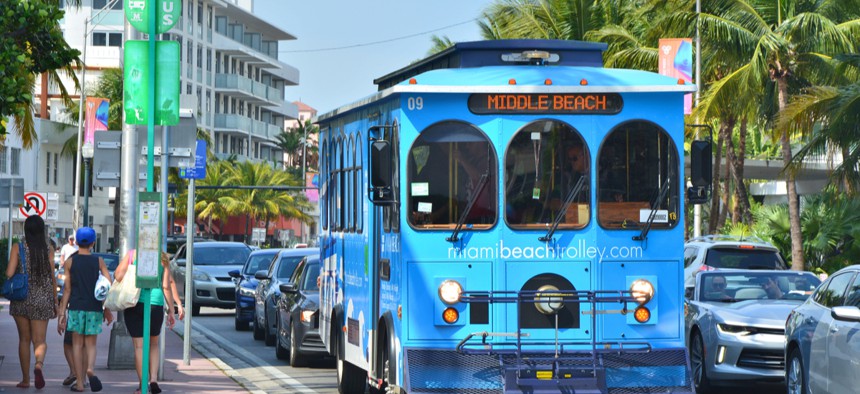Connecting state and local government leaders
In the U.S., getting to the beach usually means driving. But some sandy shores can still be reached by train, subway, and bus.
“[G]oing to the beach is not what it once was,” wrote the late David Brower, an environmental planner at the University of North Carolina, Chapel Hill, who, in a 1980 federal study on coastal access, reminisced about lying in the sun, peaceful picnics, and “isolated” walks along the shoreline. Now, he wrote, “[it] often involves long lines of hot station wagons filled with grouchy parents, sullen children, and soggy sandwiches trying to get to a crowded beach filled with bodies, beer cans, styrofoam, and stereos.”
When did the urban exodus to the ocean become such a car-centric exercise? For coastal city-dwellers in the 19th and early 20th centuries, nearby beaches were usually pretty easy to get to: In New York City, railroads connected (mostly wealthy) urbanites to Coney Island and Rockaway Beach. In Baltimore, transit companies built waterfront amusement parks along the Chesapeake Bay to promote the use of the city’s once-robust streetcar network. Los Angeles of the 1920s had one of the world’s most extensive streetcar systems, which brought Angelenos right to Santa Monica Beach. In the cities of the Midwest, railways and ferries shuttled families to the sandy shores of the Great Lakes.
Then came the highways; beach resorts became both more popular and more far-flung. As the automobile took over the job of getting people to the shore (and everywhere else), the streetcar and passenger rail lines that once brought in visitors were dismantled.
In the 1980 study from the National Oceanic and Atmospheric Administration, Brower observed that several states said their chief public access problem was getting people, particularly those without cars, to the ocean. New Jersey and North Carolina, at the time, experimented with beach-access shuttle buses from remote parking lots; Hawaii attached surfboard racks to public buses. San Francisco ran special buses from the urban center to Golden Gate Recreation Area and Point Reyes National Seashore, according to the report.
Nearly 40 years later, many U.S. beaches remain challenging to get to without a car. A 2016 survey of 1,100 beachgoers to 11 beaches in Southern California, for example, found that only 3.4 percent took public transportation to get to the waves. Nearly everyone else—89 percent—said they drive. In a separate poll by the same researchers at UCLA and San Francisco State University, 68 percent of Californian voters cited limited public transit options as a significant beachgoing barrier, especially among people of color.
From where I live in Washington, D.C., for example, going to resort destinations like Ocean City in Maryland, or Rehoboth Beach and Bethany Beach in Delaware, usually means packing the car for a three- to four-hour trip, often sitting in grinding traffic backups. Private bus companies offer direct routes, but they can cost $40 per person, round-trip, making them out of reach for lower-income families. (And you’re still stuck in traffic.) For the carless, planning a beach weekend can involve navigating a daunting public-transit itinerary involving multiple transfers between various modes and networks. And you’ll probably still have to figure out how to schlep your stuff that last mile or two to the actual water.
A few generations ago, many Mid-Atlantic beach towns were served by passenger trains bearing sun-worshippers from Philadelphia, Baltimore, and D.C.; some of those lines are finding new uses as recreational rails-to-trails projects. They’re fun to pedal around on, but, boy, it sure would be nice if they kept a beach train or two.
That said, transit-friendly beaches do exist, though they’re easier to reach from larger metropolises with extensive subway and rail systems or where the local transit agency has repurpose the right-of-way of previous networks. In Los Angeles, the county revived a segment of its defunct streetcar tracks in 2016 following some 30 years of grassroots efforts by local transit advocates to get the county to buy the right-of-way. When LA Metro finally extended the Expo Line in May of that year, it restored a direct path from downtown to Santa Monica State Beach and the nearby Venice Beach. The entire ride can take as little as just 50 minutes, costing just $1.75 each way. “It’s the only public transit of its kind that goes right out to the beach in L.A.,” L.A. County Supervisor Sheila Kuehl told Fast Company at the time.
New Yorkers still enjoy an abundance of beach access from their extensive subway system: That includes Coney Island, located at the end of the F, D, N, or Q trains, and Rockaway Beach right off the A train. The subway also offer stops at less-crowded escapes like Brighton Beach—known for the Russian immigrant enclave nearby—and Manhattan Beach, often is referred to as the calmer version of Coney Island. In the Greater Boston region, the Massachusetts Bay Transportation Authority bought and repurposed the right of ways from the old Boston, Revere Beach and Lynn Railroad, which operated between the 1857 to 1940, to bring passengers to hotspots like Carson and Revere Beaches.
But in smaller cities—even those close to the water, as the seagull flies—transit options can be scandalously limited. Wilmington, North Carolina, for example, sits less than 10 miles from the popular Wrightsville Beach. But the closest public bus stop is two miles from the shoreline, as the local news site Port Daily reports. The mobility manager of the transit system Wave cited a lack of interest from the public to extend the service. That same year though, Wave piloted a “beach bus” that ran roughly every three hours from the core of Wilmington to nearby Carolina Beach each day. That town’s mayor told Ports Daily that he had met with Wilmington’s mayor to discuss extending the route if they can come up with the needed funding.
For me, the closest sunbathing-and-sand option is Chesapeake Beach, in Maryland’s Calvert County. By car, it’s just a little over 30 miles from my office. I was semi-excited to learn that the Maryland Transit Administration runs a bus that can take you from Union Station in D.C. to a mile outside the beach. By Metro-and-bus, according to Google Maps, I could leave early in the afternoon (summer Fridays!) and be basking in the tepid 80-degree waters of the Chesapeake by dinnertime.

But then I learned that this bus runs only on weekdays. Right now, to get to Chesapeake Beach from my home on a Saturday without a car would require multiple transfers and as many as six buses. Total estimated time, according to Google Maps: 5 hours, 41 minutes.
Maybe I’ll just watch Jaws instead.
Linda Poon is a staff writer at CityLab covering science and urban technology, including smart cities and climate change.

NEXT STORY: Congestion Pricing Not Just for Big Cities, Report Says



